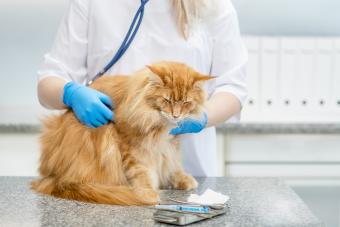
If you've ever been rudely awoken in the middle of the night by your cat scratching away at their itchy skin, you understand that skin allergies can make both felines and their owners miserable. Fortunately, you can work toward providing relief for everyone involved by identifying the type of allergies affecting your feline friend.
Cat Allergy Clinical Signs
Cat skin allergies typically produce one or more of the following symptoms, which are all part of a condition known as pruritus.
- Excessive scratching
- Licking
- Chewing
Secondary Symptoms

Pruritus, also referred to as simply "itchiness," in turn produces secondary symptoms. In many cases, these secondary signs are what owners notice and also the conditions that provide your cat with the most discomfort.
- Redness/inflammation of the skin
- Swelling
- Alopecia (hair loss)
- Skin rashes
- Lip ulcers
- Skin sores
- Scabs
- Scaling
- Chronic ear infections
- Bacterial skin infections
In addition to addressing the root cause of your cat's allergies, it's important to treat these secondary symptoms. Most irritation remains concentrated around the cat's head and front quarter of the body (the temples, ears, and neck), but allergic reactions tend to diffuse over the body as time goes on.
Causes of Cat Skin Allergies
Not all cat allergies are the same, as they have various root causes. There are essentially three types of allergies that produce a reaction that affects a cat's skin.
- Flea allergy dermatitis: This skin allergy is caused by a hypersensitivity to the saliva left behind when a flea bites the cat in order to feed on their blood.
- Inhalant/Contact allergies: This type of environmental allergy is caused by inhaling or absorbing an allergen, such as pollen, dander, or mold. It produces a condition known as atopy or allergic dermatitis.
- Food allergies: An immune reaction to certain food ingredients also produces the same immune response and subsequent skin problems.
How Allergies Develop
No cat is actually born with allergies. Instead, they develop with repeated exposure to one or more substances that trigger a response from the cat's immune system.
This immune response is quite different from the kind of response that is mounted against bacteria and viruses. In those situations, the immune system learns to recognize the invaders and produce antibodies to destroy them.
In the case of allergens, the immune system identifies a particular substance as foreign. This stimulates the system to produce a type of antibody called immunoglobulin E (IgE), which attaches itself to the allergen to neutralize it. Here lies the rub -- once the initial immune reaction has been provoked, a process known as sensitization, the allergy is established.
Each time a cat is repeatedly exposed to the allergen, it triggers the immune system to produce large amounts of IgE, which again link up with the allergen. These conglomerations travel through the blood stream until they encounter mast cells. During this encounter, the membrane of the mast cell is compromised, and it begins to leak a substance known as histamine. Histamine itself is the cause of the itching, swelling, and inflammation associated with skin allergies.
Diagnostic Methods
Narrowing a diagnosis down to an allergic reaction is not an easy process because other conditions, such as fungal infections, mite infestations, thyroid, and hormonal conditions, also present with some of the same symptoms. Skin scrapings are often used to help rule out other possible causes until an allergic reaction is the only reasonable diagnosis left.
Once it's determined that an allergy is in play, it's time to diagnose the cause of the allergy to a) try to limit exposure to the allergen where possible, and b) determine the best course of treatment. There are several ways to determine what a cat is allergic to.
Blood Test

One way is to analyze a blood sample for levels of allergen-specific IgEs. This test can reveal numerous allergies you may not even be aware your pet has because all the allergic reactions are causing the same symptoms.
Skin-Prick Testing
Another way to isolate specific allergies is through skin testing. Step one is to inject a small amount of saline in one spot as a control. Histamine is then injected in a second spot, which the vet watches to see if a welt appears.
- If the histamine does not produce a reaction, then the rest of the testing is not carried out.
- If the histamine does produce a welt, numerous suspected allergens are then injected, and the reactions are recorded.
Any substance that produces a welt somewhere between the size of the saline and histamine welts is considered a confirmed allergen.
Food Trial
Testing for food allergens often involves a food trial. This means putting the cat on a hypoallergenic or novel protein diet in order to figure out which foods produce an allergic reaction as they are reintroduced to the diet. Typically, this may take several weeks before any change is noted, but in cats with true food allergies, their symptoms resolve completely with the diet change.
Treatment Options
Treatment is most effective when an allergy is recognized early on. The first line of treatment involves removing or reducing exposure to the identified allergen(s). Good housekeeping measures will also reduce many inhalant allergens, as well as flea populations.
Medications used to treat cat skin allergies include:
- Antihistamines: These drugs inhibit the production of histamines.
- Corticosteroids: These prescription medications reduce itching and inflammation.
- Immunosuppressants: These medications suppress the immune system's reaction to allergens, providing cats with long-term or seasonal relief.
- Allergy shots: These injections can be customized to your pet's specific allergies to provide relief from the itching.
- Fatty Acid Supplements (EFAs): Although these are technically nutrients and not a medication, EFAs can reduce itching in some cases and help the skin repair itself faster.
Additional medications that might be used include antibiotics to treat secondary skin infections. A number of topical creams and ointments might also be applied to skin lesions to relieve itching and inflammation, bringing much needed relief. Avoid using over-the-counter products unless directed by your veterinarian.
Tips for Immediate Relief From Cat Skin Allergies

Although your veterinarian is the most qualified person to diagnose and treat your cat's skin allergies, you can provide your cat with immediate relief while waiting for your vet appointment.
- Address fleas. If your cat is not already on year-round monthly flea prevention, it can be a good idea to start them on one. Most flea products will begin killing fleas within the first 24 hours, so if flea dermatitis is the root cause of itching, killing the fleas is the first course of action. However, if secondary symptoms or infections are involved, your cat might not stop scratching right away. Your vet can make recommendations to help your cat during your appointment. Don't forget to treat your environment to stop the vicious flea cycle.
- Prevent scratching. Most allergic cats self-traumatize. Prevent further damage by putting your cat in the cone of shame. If you have an Elizabethan collar on hand at home, great! If not, you can find one at a local pet store. A cone will keep your cat from chewing on themselves or traumatizing the skin behind their ears, although they might still have a chance to scratch their body with their hind claws.
- Consider a bath. Avoid bathing your cat if they have severely broken, bleeding, or scabbed skin. However, for those cats with mild-to-moderate itching, a bath can help soothe their itchy skin. If your cat tolerates it, you can try bathing them in lukewarm water to cool their inflamed skin. A soothing cat-specific shampoo with ingredients such as oatmeal could also help. Don't force your cat to submit to a bath if it stresses them out, as this could exacerbate symptoms or scratching.
Itchy Skin in Cats
In the end, feline skin allergies cannot be cured; they can only be managed in order to reduce an affected cat's suffering. Early allergy detection is the key to keeping the problem from getting out of hand. Schedule an appointment with your vet to determine the cause of their allergies, then begin appropriate treatment. Soon, you and your cat will both enjoy scratchless nights free of disturbances.







